AI LB @
Do you welcome our new robot overlords?

Do you welcome our new robot overlords?
from the

I’m writing this letter with my first two weeks of school in the rearview mirror. The first correct quiz answer, the first wrong quiz answer. Forgetting to put an ice pack in my lunch box the first day. Having to ask for directions to find my first class of the term.
I was excited to enter fall, but there’s always some stress that creeps in with all the firsts of the new term. The school-work-life balance suddenly shifts heavily in the direction of the former, and it takes a little while to adjust and find the best time-management style.
I’m looking forward to no longer obsessively checking my Google Calendar to make sure I’m not missing any commitments, classes, or assigned readings I have to stay on top of. Come November, we’ll all be lean, mean learning machines in perfect sync with our schedules. We’ll make it, but October is always the awkward phase of the college school year.
But it’s great to be back on campus, right?
I was on the Albany campus a number of times over the summer, back when it was a ghost town and a construction zone. Now, I recognize one or two faces every time I walk between classes. When
The Commuter is the student-run magazine for LBCC, financed by student fees and advertising. Opinions expressed in The Commuter do not necessarily reflect those of the LBCC administration, faculty and students of LBCC. Editorials, columns, letters, and cartoons reflect the opinions of the authors. LBCC is an equal opportunity educator and employer.
The Commuter encourages readers to use its “Opinion” section to express their views on campus, community, regional and national issues. The Commuter attempts to print all submissions received, but reserves the right to edit for grammar, length, libel, privacy concerns and taste. Opinions expressed by letter submitters do not represent the views of The Commuter staff or the college.
the sun is out, the brand new courtyard is always bustling with activity.
If you’re still trying to find a way to make the campus your own, then this is the magazine for you. Our team has put together articles on useful spaces and programs such as the Fitness Center and travel abroad opportunities. We also have information on how LBCC is tackling issues such as AI in higher education and college students who are first-time voters.
If you’re interested in learning more about the history of the college, we’re continuing our “The Commuter 25 years ago” series and showcasing some sports greats of the past in our recap of the 2024 LBCC Athletics Hall of Fame induction.
And if you’d like to meet some of the incredible people who help put this magazine together each month, flip to page 18 for our “Meet the Team” feature for introductions to the many talented writers, photographers, and editors on our staff.
Our first two issues of this publication cycle were put together over the summer in a largely asynchronous way, with our staff busy with jobs, off on vacations, or otherwise enjoying their break. Now, our weekly meetings are full of people and there’s more energy and opportunities to cover the happenings at LBCC and the surrounding areas.
As campus gets busier and our staff grows, so does the number of articles. Sometimes there’s too much to print. Make sure you’re checking out our website, LBCommuter.com, to read weekly articles and stories we couldn’t cram into our monthly 32 pages. There’s a lot to talk about, but we couldn’t be happier. It’s the best problem to have.
We hope that energy is apparent as you read through this month’s magazine. We’re excited to be chronicling another school year at Linn-Benton Community College. It’s great to be back.

Ryland Bickley Editor-in-Chief
Wanna get together? We’re really nice and fairly cool and we’d love to hear what you have to say. Not big on journalism but love to journal? Perfect. Are you a STEM major with major opinions? Let’s hear ’em. Like writing about ’80s film? Local animals? Snack hacks? Maybe you have a hefty folder of flash fiction on your laptop, just dying to be published and printed. Drop us a line. We’d love to meet you, read you, and support you. Think your ideas might be too weird or too niche for submission? Even better. The Commuter is an award-winning publication because of our wide range of contributions and our unique contributors. So reach out. We’ll be staring at our email inbox in the meantime, not an ounce of chill to be had.
editor-in-chief
RYLAND BICKLEY design editor

SARAH ROSE LARSON
EMILY JIMERSON feature editor
ETHAN BIRMINGHAM
CHRIS
KAILYN MCQUISTEN reviews
STEVEN PRYOR
advisor
ROB
MASON WILLS contributors
BRENDA AUTRY
BRITTANY
JESSICA REYNOLDS
MICAH
MIKA WINDER
MIKE
SCOTT SUTHERLIN WANT











graphics by KAILYN MCQUISTEN
Do you welcome our new robot overlords?
words by RYLAND BICKLEY
If higher education were to dress up for Halloween, it would probably be as ChatGPT. The threat of artificial intelligence has rapidly become the boogeyman of countless industries, but perhaps none more than in education, where AI threatens not just job security but also academic integrity.
AI might scare faculty, but it’s a worry for students as well. The 2024 Digital Education Council Global AI Student Survey reported that over half of students polled believed an overuse of AI devalues education, although 86% admitted to “regularly” using the technology.
ChatGPT and other artificial intelligence tools have become prevalent to the point where they can’t be ignored any longer. Following inservice days ahead of the 2023-24 school year, LBCC’s Vice President for Academic and Student Affairs Ann Buchele launched an AI task force. It first met in March of 2024, co-chaired by manager for Student Conduct and Retention Jill Childress and counselor and advisor faculty Sonya James.
The task force is set to run until spring of 2026, with goals to create school policy on AI, offer training for faculty, create a library of resources, and “launch a community of practice for faculty to be working and supporting each other through what AI use looks like from a pedagogical and curriculum perspective,” said Childress.
Childress presented an update on the state of the AI task force during inservice ahead of the 2024-25 school year.
The 15-person team has yet to make significant updates to the school’s reaction to AI, but on a topic that complex, time is needed. “The technology is changing daily …
we want to make sure our recommendations are not too rigid,” explained Childress.
A number of basic AI recommendations were given out during the inservice session. Instructors were urged to have AI policies in their class syllabi, with the task force offering guidance and examples to those who were unsure where to start. There were also warnings about the fallibility of AI-checking programs, which are seen as useful tools but not recommended to solely determine whether a student’s work was AI-generated.
But the AI problem involves far more
Childress and the rest of LB’s task force recognize the many pitfalls of AI, but the end goal remains to implement it into the school’s structure before higher education falls too far behind in the use of the rapidly developing technology. While still in its infancy, the task force is the first step towards LB entering the future of academics, the workforce, and beyond.
However, most Linn-Benton instructors have been dealing with AI long before the task force was formed. The consensus seemed to be that 2022 – when ChatGPT updated
want AI to do the thinking for them, but I recognize that AI can be a tool that helps them with learning and thinking.”
In computer science, Jess has a similar stance: “My policy is basically, if I ask for some requirement in an assignment, I want you to have written that. If it's anything else, I don't care where it came from, but I would like it to be cited.”
than just academic integrity. Childress highlighted equity concerns, ethical and security implications, environmental impact, and community and workforce applications as factors the task force has needed to consider.
For instance, some companies have begun to look for candidates with AI competency, something the school needs to consider when preparing students for the workforce. And because some programs such as ChatGPT learn from user input, instructors were warned of potential FERPA violations regarding entering personally identifiable information into AI tools. The task force said to use AI programs that cannot access the school's database
Although individual instructors are still open to make their own class policies, completely banning AI was not one of the options for LB’s task force.
from version 3 to 3.5 – is when the first wave of generative technology hit the classroom.
“A couple years ago is when I first started seeing it really hit big,” said Joseph Jess, a former computer science instructor at LB now at Oregon State. “And of course, it's all over the place now. It's one of the fastestgrowing things that we've seen, definitely one of the fastest-growing things I've seen in influencing student learning processes.”
Most faculty have had to adapt to the new technology, although AI stances vary with each class and instructor.
Mark Urista, a communications instructor, flat-out encourages students to experiment with AI as a tool for brainstorming and debate practice in his argument and critical discourse class. However, he recognizes that a course where most assignments are delivered orally has more built-in protection from AI than an online writing class.
Jess went on to state how using external sources has never been uncommon in coding, although in the professional world, uncited code can be a headache. It’s made worse by the unclear origins of some AI-generated work.
“I want [students] to start to gain an intuition of an ethic or something like that. … If they become a software engineer, they're going to have to state exactly where something came from,” Jess said.
Lewis Franklin, the program chair of LB’s Visual Communications program, is able to go without an AI policy because he works with students throughout their entire creative process. “If you're very careful about it and you only use it as an aid instead of a solution, you're using it the way it should be used,” he said.
However, licensing is an important factor to keep in mind. While Adobe and other visual software have programs that generate from only licensed materials, others do not. Said Franklin, “I try to train my students as best I can to be cognizant that they’re working for clients. Sometimes there's millions of dollars at stake, and you can't play this game
“Using AI as a tool is the direction we’re headed in,” said Childress at inservice, noting how the task force itself was using the technology to organize its goals and synthesize data. With AI now readily accessible and built into many web-based educational tools, it’s getting harder for faculty to treat their coursework like AI never existed in the first place.
“I've been really surprised at just how useful it is as a tool,” said Childress. “I think just the iteration of it that we're seeing now – there's a lot that it's capable of doing in ways I think can really save us a lot of time and then free us up for maybe more complex work or more sophisticated thinking.”
“I encourage students to use AI to develop arguments for and against the proposition that they have been assigned, and then they can begin to analyze how strong those arguments are,” said Urista, adding, “You have to consider the class and the context in which AI would be used. I really feel for faculty that teach writing classes or classes where calculations can be done very quickly with AI.”
“I want to teach students how to use AI well, but that's something I'm still trying to figure out,” he said. “Bottom line is I want students to use AI as a tool and not as a crutch. Students are in college to learn and to develop the ability to think. I don't
of borrowing from non-reputable sources.”
Anthropology instructor Lauren Visconti devotes around two pages of her class syllabus to AI usage, including a bulleted list outlining when it is and isn’t permitted:
For example, the following learning activities permit the use of generative AI tools (e.g. ChatGPT, Bing, Gamma, Claude, etc.)
• Brainstorming and refining your ideas;
• Finding information on your topic;
• Drafting an outline to organize your thoughts, or;
• Checking grammar and style
>
The use of generative AI tools is not permitted in this course for the following activities:
• Writing a draft of a writing assignment;
• Writing entire sentences, paragraphs, or papers to complete class assignments;
• Generating Powerpoints, slideshows as assignments.
Visconti also uses AI as a tool in her classroom at times. At one point, she wrote “What does it mean to be a human?” into ChatGPT for the class to analyze. “I think that could be a positive in bringing critical thinking skills around technology,” she said.
mean, people use it. That happens,” she said. “I have my own personal issues around it, because I feel for authors and artists, and I feel if we have great, amazing machine learning, why aren't we using it for, like, farm work – I don't know, cleaning toilets. Like, why are we using robotics and large data sets for really great things?”
“So I don't outlaw the use of AI – just when people turn in papers, I want those to be written by them,” she said. “And if they're stressed out, I want them to come to me and say, ‘Suzi, I can't do it this week.’ Like, OK, let's talk. That's a level of trust you have to have in your professor. Me, I have to trust my students.”
have that conversation with a student, and nine out of 10 of them would say, ‘Can you just give me the weekend to try and remake this?’” said Jess. “Show me what you got at the end of the weekend. If it looks like you're legitimately trying, you're good to go. And I know some people have really strict policies on that kind of thing, oppressive policies, I might say. It does not foster learning to just say, ‘Get out of my class.’”
Jess also highlighted ways where AI could be an improvement over the questionable online learning resources of the past, mentioning a newly-developed “rubber duck” program. Rubber duck
While AI tools can be a powerful brainstorming tool, anthropology instructor Sarah Walker added that they are still far from perfect, often amplifying the shortcomings of internet search results.
“I've used it to show students hegemony in history teaching and the teaching of what indigenous people are and are doing,” she said. “Because if you go into ChatGPT and you ask questions, like, ‘Who are the Mayan people?’ I've had students look at it and then basically go through and say, ‘Oh, well, this isn't true.’ And so it's reflecting a lot of the biases that are already within the culture. It's a computer [program] written by people, so it's going to have all those problems.”
ChatGPT can also struggle to keep up with changes in culture and information.
“You have the data on Monday, and then something drastically changes because it's humans and culture on Tuesday – ChatGPT is
“What I always say is, look, if it looks like AI wrote this – maybe you weren't using ChatGPT, maybe you weren't using OpenAI, I don't know, but it looks like it was, so just revise it. And please don't complain to me. Just go, ‘OK, I'm going to revise this so it sounds more like me now,’” she said.
“And sometimes that means that people end up with some kind of unpolished writing. You know, people are between their freshman and senior years of college – you're not going to be good at everything, not going to be perfect. You just have to get better as you go.”
Steffen outlines a forgiving stance many instructors are taking with AI cheating incidents. With the stress of college and the increasing accessibility around AI, many students are being given second chances to submit their own, original work.
“Some bad uses of AI – I would say for the most part, it's people who run out of
debugging is a term for explaining code to someone or something — an inanimate object like a rubber duck – and discovering mistakes and solutions through the process of explaining every detail.
“They made this AI rubber duck that was trained to be sort of a Socratic method, asking questions to clarify student questions so they can then learn. And this thing can be available 24/7, right?” said Jess. “Unlike a TA or an undergraduate mentor or your instructors or professors, it's available in the evenings. It's available on the weekends, and it's trained in a way that doesn't just write code for people. So it ends up still trying to teach them all of the basics of this thing without just throwing an answer at them like Course Hero or other Chegg sites might do, where it's like, ‘Oh, we've already got an answer for that question.’ OK, how much are you going to learn by copying and pasting it, though?”
going to give you the same s— on Wednesday that it gave you Monday,” added Visconti. “It does not matter what happened on Tuesday. And that's scary, because it can prohibit cultural change.”
Journalism and writing instructor Suzi Steffen’s classes follow a similar policy to Visconti’s: AI is allowed for developing ideas, but student work must be completed by students. However, in Steffen’s case, the use of AI is reluctantly permitted.
“I prefer people not do it just because of the environmental impact. But I mean, for brainstorming, what are you going to do? I
time,” said Jess. “They just ask a question of ChatGPT or other AI, and it spits something out. It kind of sort of works. They're hoping for partial credit, right? … And I've had more and more of those as the past couple years have gone on, but my policy has remained roughly the same, which is, I will have a conversation with you as the student before I report you, because it's entirely possible that maybe you just ran out of time, and you're still willing to put in the time to do it correctly.”
“And so there were several times, a couple times per term, while I was at LB where I would
“I love the fact that AI can now serve as a tutor for students, particularly disadvantaged students who may not be able to access a tutor on their own,” said Urista. “I also love the fact that AI can provide something like a second reader to students. I remember back when I was in college, whenever I wrote a draft of a paper, there were lots of typos, lots of grammatical errors, and someone at the writing center could help me identify what those were and improve the paper. Well, now we have Grammarly.”
Walker stated how she wishes students would use AI: “Be transparent. Don't try to
be sneaky about it. Tell your professor, like, ‘Hey, I'm using AI for this, and it really helped me.’ You know, ‘I used AI for this, and it was just terrible and I don't know why everybody thinks it's so great!’ Whatever –we're learning, too.”
However, there’s also an emphasis not to make it too easy for students to turn to AI tools to complete coursework.
“I put the onus of responsibility on the instructors,” said Urista. “Instructors need to figure out how to essentially make their class AI cheat proof.”
“One thing I would recommend that all instructors do is use AI to complete some of their assignments,” he added. “That's probably the best way for them to get insights on what adjustments need to be made. … Once ChatGPT came on the scene, I started to complete [speech analysis assignments] with ChatGPT, and I realized AI can complete a good portion of this assignment without the student putting any original, critical thought of their own into it.
“Now, a lot of my papers require students to analyze speeches and debates that happen in class, specifically because I know AI cannot make connections between a lot of the content that we're teaching and specific examples from those speeches in class. Making those connections are critical.”
“I'm starting to ask for handwritten things,” added Steffen.
But students may not all be as likely to use AI as some think. “One thing I'm hearing from my colleagues about students is that they're not necessarily as on-board with AI as we might think right out the gate,” said Childress. “I mean, I'm sure plenty are, but there are still some reservations there, too.”
“One thing I would encourage my colleagues and other folks in higher ed to do is bring students into these conversations and let them know. I want you to speak honestly and authentically. Tell me the good, the bad, and the ugly. We need that kind of honest, transparent communication to occur if we're really going to figure out how to chart forward in a productive way.”
Childress added that students can reach out to her or Sonya James in the Advising Center if they want to share their feedback or experience with AI at LB.
“We’re delighted to meet and hear from them, and get their perspectives, and then if there's a lot of energy there, we can figure out ways that we can get them plugged into the group,” she said. That feedback and dialogue could prove important as LBCC and other colleges plow into the unknown future of AI.
“We're all going to be replaced by AI at some point or another,” said Franklin. “As AI starts to make more and more web pages and starts to do a lot of the other graphic design work, of course it's going to have a hugely negative impact on what we do.”
“But the AI can't sit down with clients and discuss things and figure out the human pieces when you're dealing
AI. And if you asked, like, eight years ago, what's going to happen next with crypto, they would have been like, ‘It's the most amazing thing ever.’ Well, I think that these are folks who live on their wits. They want venture capital. They want to be able to say, ‘I'm pivoting to this next best thing.’ So I'm not sure that it's going to hold up. But who knows?”
Still, she warned about the effects of students over-relying on AI to eke out a degree: “What did those students learn? Well, they learned that if they were good enough [with AI], or their teacher was tired enough, or whatever – I mean, that is the way life works. But when we need somebody doing research to not cut a corner, for example, healthcare research or nuclear physics research or something, I don't want that to happen.”
“I don't know, maybe ‘frightened’ is too strong of a word,” said Visconti. “But email was supposed to reduce our work and time [laughs]. … So I'm skeptical until we are able to put labor at the forefront of a new technology.”
Childress has mixed feelings as well. “I guess I believe in the resiliency of humans, and so I think it's easy to be a little afraid of what could come, but I'm hopeful that when we have people who are smart and capable and creative, that we will figure out ways to help guard against some of the potential
“I don't think a ton of students actually use it,” said Alex Loveday, who was the Student Leadership Council representative on the AI task force.
Still, Urista notes that the younger generation seems to be more comfortable with the technology: “Something I've accepted is that students are always going to be one to two steps ahead of me. I've actually learned more about AI from my students than I have from any of my faculty or administrators or professional development training sessions that I've gone to.”
with branding and you're dealing with graphic design, because you're dealing with people, not with computers at that point,” he added. “And so I don't know – I can't imagine AI being able to replace that real interaction. You can replace a doctor with an AI, but what about bedside manner? You know, that human component that we need and crave. So, it's a double-edged sword.”
Steffen was less confident in an eventual AI takeover. “I read someone talking about how all of the people who were into crypto are now into generative
pitfalls of generative AI,” she said.
“So I think I'm overall optimistic, and I'm hopeful that it's a technology that can really free us up to do really cool, interesting work. … I'm interested to see where it goes – I think I'm in camp optimism.”

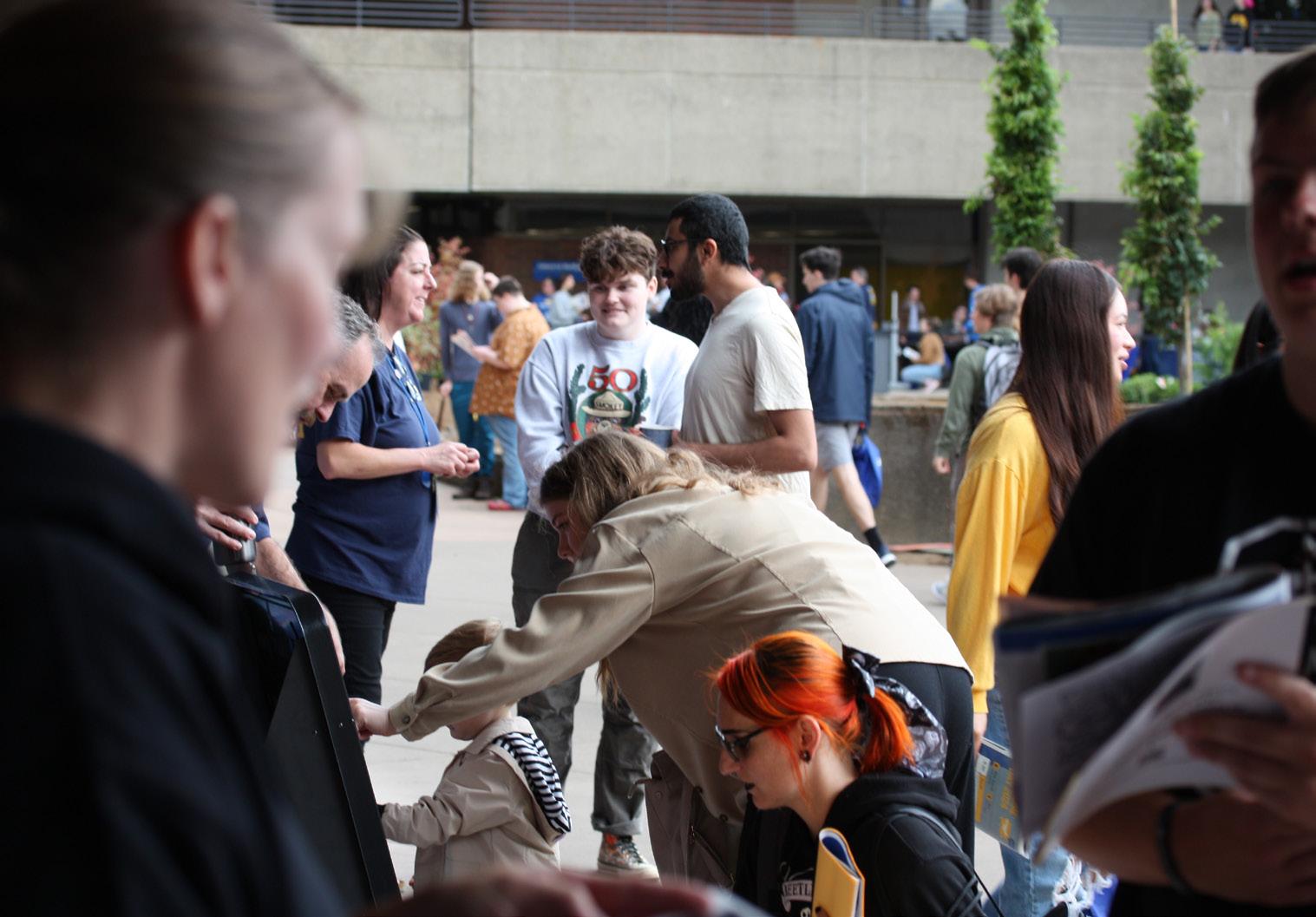



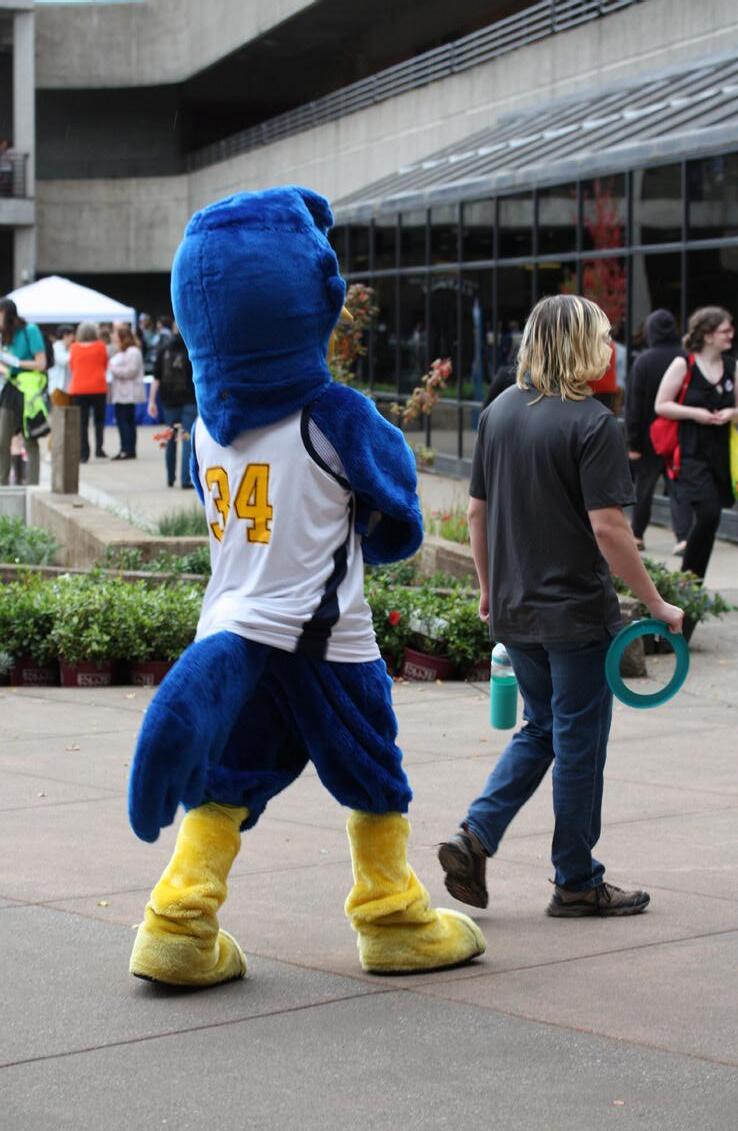


words by SCOTT SUTHERLIN
photos by MIKE MCREYNOLDS
Walking toward the LBCC courtyard, you could feel the energy in the air as students navigated through various booths that provided valuable information and resources to help with the upcoming term.
On Wednesday, Sept. 25, Linn-Benton Community College buzzed with excitement as students, faculty, and the rest of the staff gathered for the highly anticipated Welcome Day. This event marks the new academic year.
The day kicked off at 9:30 a.m. and continued until 3:30 p.m., offering activities designed to welcome new and returning students.
First-Year Seminar classes, which began at 9:30 a.m., were mainly for incoming freshmen and showed the college’s commitment to students, providing essential tools and support to ensure a smooth transition into college life. It gave the students a chance to meet their instructors and peers, which set the stage for an engaging academic journey.
Students had access to a wide variety of resources and activities throughout the day. From academic advising and course registration support to campus tours and club fairs, there was something for everyone. The event also featured interactive workshops, health and wellness booths, and social activities for a sense of community among the students.
Students expressed enthusiasm for the new year. Said one student, “I got all my questions answered and feel much more confident about starting classes next week.”
Another student said, “I’m really looking forward to this semester, especially after seeing so many others smiling and good energy coming out.”
The event helped students, new students especially, get some confidence and see how many resources are available to them at LBCC.


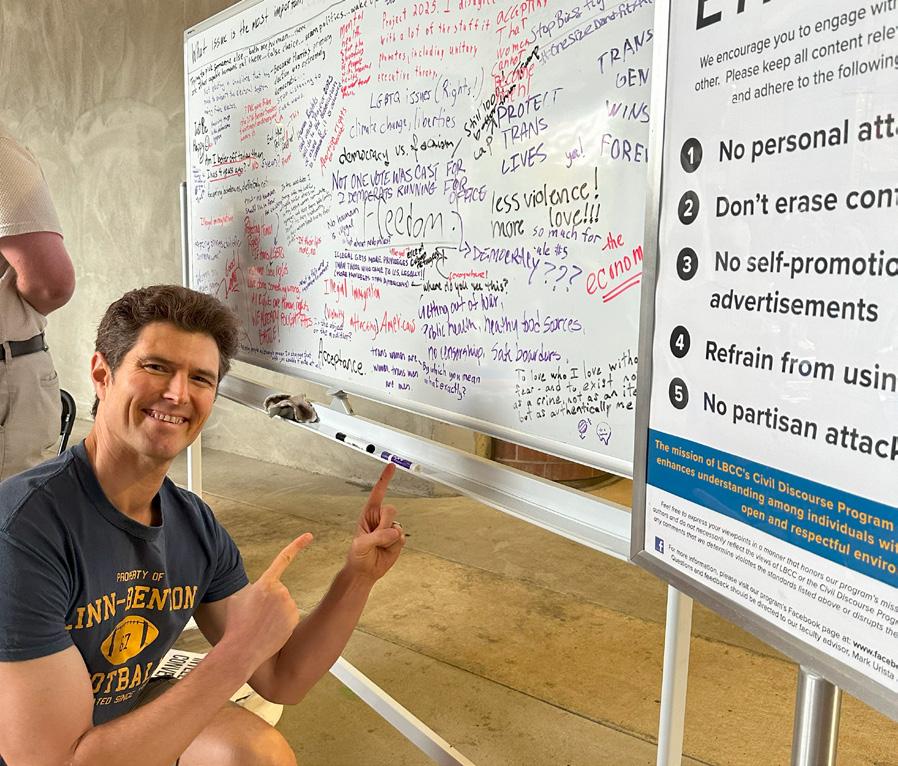
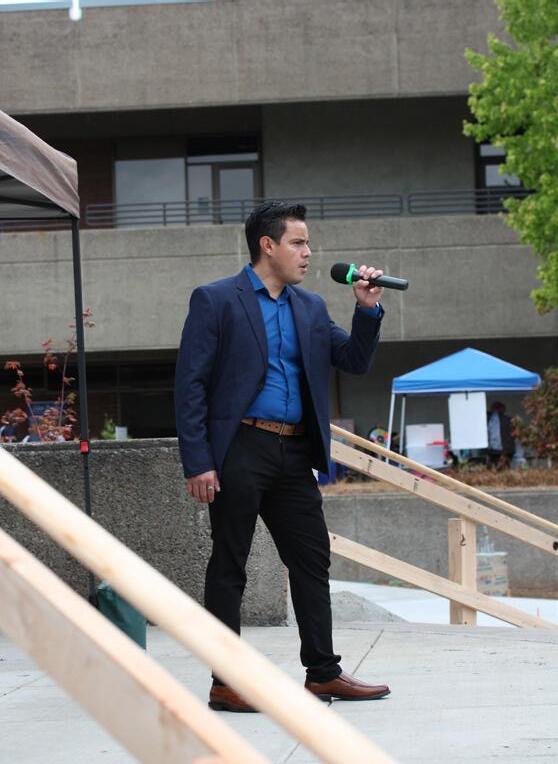



There’s never been a better time to check out LBCC’s recently renovated Fitness Center.
Over the summer, Linn-Benton staff and faculty renovated and upgraded what had previously been dubbed the "weight room" into a state-of-the-art exercise facility.
The renovations added brand new workout machines, removed outdated and unused equipment, and incorporated a reception desk for the center's student employees.
"For the most part, it's nothing but upgrades," said Dean Upton, a Fitness Center employee of the last two years. "I promote it to anyone I can in my classes."
Upton, a second-year bioengineering major and former martial arts instructor, works out at the Fitness Center in his free time. Even though the school year has just started, Upton has noticed an increase in the amount of consistent visitors to the center.
Students and staff have been free to test out the new equipment that was set up, like the stair stepper, the three high-tech treadmills, and the two additional squat racks.
Upton would like to see an extra cable machine added to the center in the future, but he believes the decision to bring in new cardio equipment was necessary.
"I use the Fitness Center a lot," he said. "It has everything you're going to need for any specific muscle workout."
The process for students and staff to use the center takes almost no time. Before using the gym, new visitors must sign a one-time waiver, which they can fill out at the reception desk. Gym-goers then sign in with their physical or digital LB ID card, after which they are free to work out and enjoy all the Fitness Center has to offer.
No one is required to have a rigorous workout to use the Fitness Center. The space offers a rowing machine, elliptical
machines, and exercise bikes for guests wanting a more relaxed gym session.
With the removal of last year's unused fitness machines, there is now more floor space for yoga, stretching, and core workouts, which has pleased visitors.
"Last time I was here, it was kind of packed with all the equipment," said Leon Souther, a regular Fitness Center visitor. "They made incredible improvements."
Souther, a second-year occupational therapy assistant major, had observed some of the center's flaws when he first started attending.
Souther encountered issues like waiting for squat machines to open up and feeling cramped due to the number of unused machines taking up space.
With more room to operate and two more squat machines, he no longer has to wait for an open spot and can enjoy a more intensive core workout on the floor space.
"It's a really good place to meet a lot of new people here. You can work out with your buddies, and it's a really nice gym," Souther said.
Planning for the Fitness Center's renovations started in early May when Rob Camp, manager of Student Life and Leadership, sent out an email with an attached survey to gain student feedback on the center.
After examining the responses, staff and faculty worked throughout the summer to transform the Fitness Center into a facility that mirrored Oregon State University's Dixon Recreation Center to a lesser extent.
The result has left students, coaches, and staff satisfied with a modern facility that emphasizes the need and importance of physical well-being.
"It feels as if we're getting a much better response from the student body than we've had in the last couple of years," said Todd Zimmermann, manager of Fitness Center operations and head coach of the men's basketball team.
Zimmermann and his team hold threehour-long sessions in the Fitness Center for three days a week. He says that so far, the upgrades to the Fitness Center have been met with great enthusiasm from Linn-Benton's student-athlete population.
Even with the overwhelmingly positive responses, Zimmermann still has ideas for future improvements to the Fitness Center. He hopes to install more storage space for personal belongings and a paved outdoor area for tire flipping.
The ideas will most likely have to wait until later to become reality, but in the meantime, Zimmermann encourages all students and staff to stop by and check out the Fitness Center's latest updates.
"We're creating a facility that will serve the diverse needs of students, faculty, and staff," he said. "You just gotta come over and give it a look; you'll find something that fits your fitness goals."

words and photos by BRITTANY KING



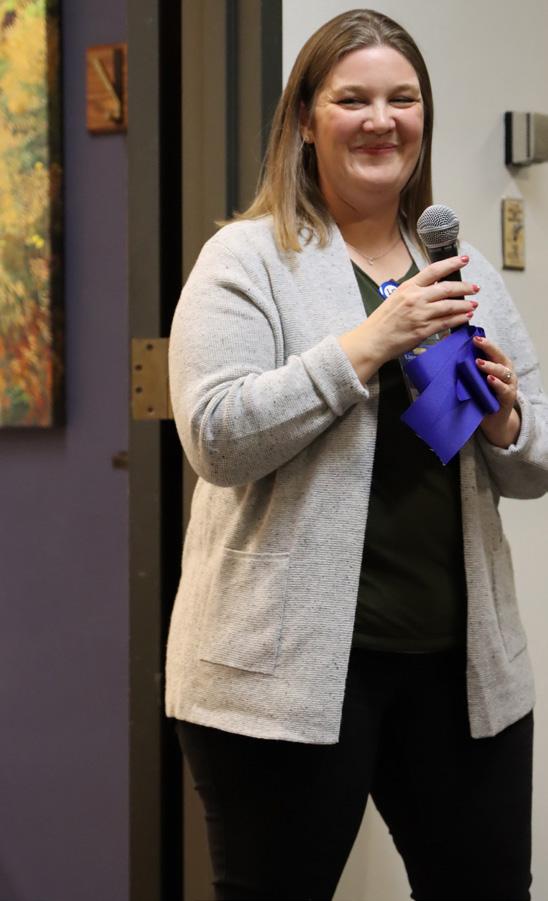
LBCC’s accessibility department hosted the grand opening of Forum 114 as one of the Albany campus’ remodeled and newly designated lactation spaces with a ribbon-cutting ceremony and celebration on Thursday, Oct. 2.
Each space is equipped with a brand-new, comfortable reclining chair, nearby running water, a refrigerator, and a microwave. The excitement was palpable as Forum 114 replaced the Room of Requirement that once served as a makeshift lactation space in the library. In addition, spaces also have been dedicated in Red Cedar Hall 121, and in Chinook Hall at the Corvallis Campus.
The project to create the dedicated spaces was a team effort. Dean Katie Winder in Academic Progression aided in scouting potential spaces with running water. Stacie Braun and her team in Facilities helped with the acquisition of items, prepping the spaces, painting, installing fixtures, and other facility-related tasks.
Melissa Williams managed the Title III retention grant and helped with the affordability of the project. Nuria Gamarra of the Student Retention office took the lead in the functionality and design of acquired items as well as managing logistics and signage. Art instructor Anne Magratten donated a few of her landscape pieces to the art featured in the lactation spaces as well as helped to source other artwork from the LBCC community. The project also received support from Carol Raymundo in Accessibility Resources.
The overall vision of the dedicated lactation spaces is to provide a safe and comfortable environment for lactating staff, students, and guests.
“We believe that offering lactation space is an important way to support our community,” said Jill Childress, the manager of Student Conduct and Retention. “We don’t want the need to lactate and a lack of private space to do so to be a barrier to accessing education or otherwise create an unwelcoming environment at LBCC. Providing these dedicated spaces is the right thing to do, and helps contribute to a campus ethos of a welcoming community that is inclusive and celebratory of all of its members.”
Forum 114 is now available for use. To gain access to the private space, you can contact Accessibility Resources in Red Cedar Hall or by email at accessibility@linnbenton.edu.


words by MIKE MCREYNOLDS
Young voters are excited to vote this fall because it’s their first time, while also being nervous of how important their vote is.
The fact that they could be the generation to elect the first female president of the United States has some energized. They also are excited to finally have a say about issues such as women’s rights. On the other hand, some remain undecided over who will get their votes come Election Day.
During Welcome Day last month, The Commuter spoke with a number of students about voting, primarily asking two questions:

Is this the first time that you are voting? Yes or no?
Who or what are you most interested in voting for? Why?
Twenty-one students took the survey, which brought a variety of answers. For the first question, two-thirds of students – 14 out of 21 – said this is their first time to vote. Of the first-time voters, 11 of them are 18 years old. The oldest first-time voter was 24 years old.
The answers to that second question were varied. The most mentioned answer was split between being excited to have a voice on equal rights and still being undecided.
LBCC’s Student Leadership Council (SLC) staffed a booth on Welcome Day and the first week of school to encourage students to register to vote.
“I think the voter registration went well!” said Will Vellinga, legislative affairs director with the SLC. “We've had a lot of support from teachers and volunteers who care about people using their voice to vote for their interests.”
“Something that stood out to me is how jaded the younger population is,” he continued. “It's interesting that the older you are, the more you care about or believe in our democracy. There are a lot of issues young people could take interest in and vote in favor of bettering their lives here in Oregon, but most think about the presidential election over the far more impactful local elections that affect us directly. The big picture matters but so do the details.”
Elliott and Mika, two 18-year-olds, both said they are “most interested in equal rights for marginalized groups.”
Two more 18-year-olds joined by a 24-year-old said they are still weighing their choices, with one writing, “I haven’t given much thought to who I’m voting for.”
Among the other responses, students said they are concerned about women’s rights, voting for candidates and measures that reflect their beliefs, and that they are “turned off by the other candidate.”
A student named Arcelia said, “I’ll vote based on how my beliefs align with those who run. It isn’t about what party you are with, it’s about doing what’s right!”
The choice of who they would vote for in the presidential race was lopsided in favor of Vice President Kamala Harris. Of the 12 people who wrote down their choice, she received nine votes to three for former President Donald Trump.
Students said they had a feeling of hope for the future with Harris and a belief in her plans for America. Another Welcome Day attendee named LeAnne said she is voting for Trump “because he’s not Kamala.”
Traditionally, voter turnout for primary elections lags behind the general election, at only about 30 percent. General elections usually have a turnout closer to twothirds of voters.
Ballots will be mailed to voters starting Oct. 16, according to election officials. All ballots must be turned in by 8 p.m. on Election Day, which this year is Tuesday, Nov. 5. Mail-in ballots must arrive at the local elections office or be postmarked by that deadline as well.


Linn-Benton Community College has partnered with the Knife Rive r Training Center to provide a comprehensive learning experience, to get you on the road with your CDL!
• FMCSA-compliant CDL training
• Tuition cost: $6,499
• Comprehensive training materials
• Daily catered lunches included
• Third-party DOT skills test
• Unrestricted licenses
• Real-world experience delivered at the Knife River Training Center in Albany, OR
• Professionally trained and highly experienced instructors
• Start driving and backing the first day of class
• We don’t rely on simulators
• Just over 3 weeks, Monday-Friday, 7:30 am4 pm
• Manual transmission trucks
• 3:1 student-to-instructor ratio, resulting in a high first-time pass rate
• Students train on 1.5 miles of closed circuit training roads before driving on public roads
• Complete the Application at: www.linnbenton.edu/CDL
• Email it to CDL@linnbenton.edu
• LBCC Coordinator will contact you within 2 days




words and photos by SARAH ROSE LARSON
Costa Rica, known for its lush rainforests, vibrant culture, and commitment to environmental preservation, provided LBCC students with an unforgettable study abroad experience this past summer.
The program, focused on public health and cultural immersion, offered a unique opportunity to explore the country's diverse ecosystems and gain valuable insights into its healthcare system.
Students and Linn-Benton instructors were captivated by Costa Rica's natural beauty, which reminded them of Oregon's forests with a tropical twist. The country's commitment to environmental conservation was evident throughout the trip, as evidenced by the emphasis on sustainable practices and preserving biodiversity.
The trip from June 21 to July 6 was filled with memorable experiences, such as hiking through the Monteverde Cloud Forest, zip-lining through a forest canopy, and visiting a sloth sanctuary.
However, there were also challenges, including language barriers for those with limited Spanish proficiency and adjusting to the slower pace of life in Costa Rica.
To prepare for the trip, students engaged in language learning, cultural research, and meetings with faculty who had previously visited Costa Rica. These preparations helped students become more familiar with the country’s culture, history, and language, enriching their experience.
While in the country, students were supported not only by LBCC faculty Kristi Murphey and Lisa Hoogesteger, who lead students to meet course requirements for LBCC credits, but also the Monteverde Institute, a non-profit dedicated to environmental conservation. LinnBenton Community College also worked with the Institute for the 2023 Costa Rica study abroad trip. The Institute worked hand in hand with LBCC students, setting them up with housing, arranging travel, tours, and being fully available for anything they needed.
The program's academic component focused on public health as well as cross-cultural health and wellness. Students had the opportunity to learn from experts and apply their knowledge through various experiences, including visiting hospitals, schools, and medical clinics.
“It was nearly 100% experiential learning, not something that happens often in the nonCTE programs,” said Murphey.
The program also provided opportunities to explore traditional and alternative healthcare practices and better understand public health issues in Costa Rica.
One of the most surprising things students said they learned about Costa Rican culture was the strong emphasis on family and community. Despite the country's economic challenges, the locals were always willing to help one another, demonstrating an inspiring sense of solidarity.
Students and faculty have advice for those considering a study abroad trip. They emphasized the importance of being openminded and willing to embrace new experiences. Participants also recommended learning some basic Spanish to facilitate communication with locals. Finally, they encouraged future students to take advantage of the opportunities to explore the country's natural beauty and cultural heritage.
LBCC Study Abroad programs to Costa Rica have provided students with a transformative experience that enriches their academic and personal lives.
“Traveling anywhere broadens our thinking and widens our view of other cultures, priorities, family structures, architecture, transportation, food, and sports,” said Hoogesteger.
By combining academic coursework for LBCC credit with cultural immersion and adventure, the program offers a unique opportunity to learn and grow as well as a new way to appreciate the beauty of the natural world.



The Linn-Benton Community College study abroad program to Prague offered culinary arts students, other students, and even faculty an unforgettable opportunity to explore the Czech Republic’s rich culinary traditions and vibrant culture.
From sampling traditional dishes, attending cooking classes and learning about the historical significance of Czech cuisine, students gained an appreciation for the country's gastronomic heritage. The program from July 8-19 gave students the opportunity to go on culinary excursions. Students participated in food tours, exploring various restaurants and markets to taste a diverse range of Czech dishes.
“For the rest of my life, duck and dumplings will always remind me of Prague,” said participant Jason Pfahler.
Students also learned about Vietnamese cuisine and culture. They learned how young Vietnamese people immigrating for work and study as part of an agreement made between Czechoslovakia and Vietnam during the communist era is a significant part of modernday Czech. This included a food tour through the Vietnamese Sapa Market.
Students had the chance to attend a lecture with world-class chef Ladislav Florean, who is a private chef in Czech. He currently works for actors while they live in the country during filming and other famous people. Chef Florean has experience working in Michelinstar restaurants around Europe.
A highlight of students’ learning in Prague was attending a cooking class, where they learned to prepare authentic Czech cuisine from a team of chefs in a kitchen classroom. This was a great way to gain valuable culinary skills and learn how to make some of the dishes they had been learning about.
The program incorporated various cultural immersion activities, providing students with a deeper understanding of Czech cuisine’s historical and cultural context. By visiting historical sites and learning about the country's past, students could connect the dots between the food they were experiencing and the people who created it.
Beyond the culinary experience, students toured historic cathedrals and castles and some attended a performance of the opera “Don

Giovanni" at the National Theater, the same place where Mozart first performed it in 1787.
Linn-Benton faculty chefs Josh Green and Stacy Lebar led the trip, facilitating discussions, offering mentorship, and challenging students to think critically about what they were learning and helping them to meet learning objectives for LBCC credit.
Additional support and assistance was offered throughout their stay in Prague from CIEE (Council on International Educational Exchange). CIEE is a non-profit organization promoting international education. They organized tours with local experts, hosted classes at their center in Prague, and set students up in CIEE apartments within a beautiful Prague neighborhood.
Participating in this study abroad program offered students many benefits, including a deeper understanding of Czech culture, history, and cuisine; practical culinary skills, enhanced professional development, and personal growth.
Advice students had for those considering a study abroad trip included being open-minded to the differences in culture, bringing some good walking shoes for the cobblestone streets, and being prepared to pay for water in the restaurants. Some students found that a glass of water is sometimes more expensive than beer in Czech.
Chef Green organized several fundraisers before the trip. The funds raised through these efforts were directly allocated to student costs, significantly reducing the trip's price.
The success of this study abroad program has inspired plans for future culinary trips to Prague and other destinations. Green aims to allow more students to explore different cultures and expand their culinary horizons.
This year's Summer 2025 trips will give the opportunity for students to study in London, South Korea, or once again Costa Rica.
Study abroad to London will be led by LBCC faculty Laura Jones and Scott McAleer. Students can choose between psychology or history courses for LBCC credit while exploring the city's rich history and culture.
Performing Arts Department Chair Raymund Ocampo will lead students to South Korea this summer.
This year’s trip to Costa Rica will focus on science, led by LBCC faculty Jeremy RandolphFlagg and Diana Wheat. The program includes exploring the lush rainforest, participating in cultural activities, and gaining experience in scientific research. Led by experienced faculty and once more the Monteverde Institute, this trip will offer the opportunity to gain college credit while learning about Costa Rica's diverse ecosystems.
Visit the Study Abroad section of the LBCC website, or email studyabroad@linnbenton.edu for questions and to be added to the email list.

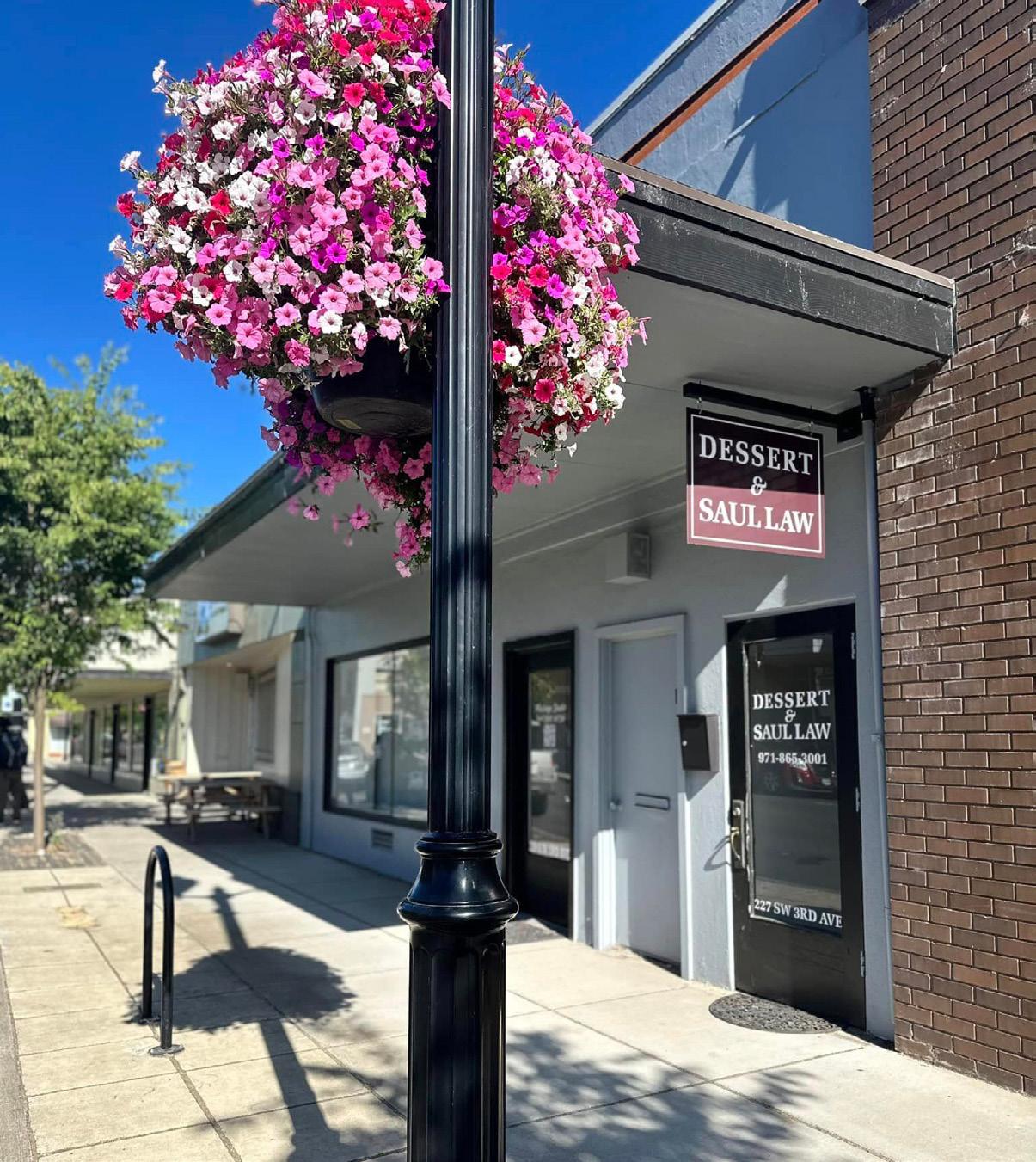
Application deadline: January 17, 2025
Orientation: April 2025
Trip: Approximately two weeks in late June to early July 2025.
For more information, scan the QR code below!

Want to get involved with student leadership, event planning, or club engagement?
The Student Leadership Council is looking for more members!
We need:
-Event Planners
-Executive Assistant
-Club and Engagement
Director
-Judiciary Board Member
-Rocky the Roadrunner Mascot
-Interns (first-year students)

Reach out to slcpres@linnbenton.edu for more details, or stop by the Student Union in Forum 120, right next to the Roast Runners Coffee Shop.
We are open Monday - Friday from 9am - 4pm. We offer a cool place to hang out with board games, arcade games, air hockey, foosball, TV, free coffee and cup o’ noodles to enjoy.
All students are welcome to enjoy the benefits the Student Union offers. All students are welcome to enjoy the benefits the Student Union offers.
Check out Student Leadership
Media accounts to discover the latest campus happenings:

Check out a funny SLC TikTok:



kailyn_mcquisten (design editor) I am a graduate of LBCC’s Vis-Comm program and the running design editor for The Commuter for the past few years! Outside of The Commuter, I also work with Community Education here at LB, illustrate, game, and spend time with my partner and our two cats!
Go-to weeknight meal: Orange chicken or some katsu and rice.


brenda_autry (contributor) I’m an LB alumni and have been an employee here since 2016. I’m also currently working on a second degree in journalism. I love writing, photography and travel and I’m so happy to be able to contribute to The Commuter. Although I love covering things around campus and writing personal profiles of our amazing students and faculty, my favorite stories to write are definitely my travel stories.
Go-to weeknight meal: Tacos! Veggie, bean, egg, turkey, or beef. So versatile!
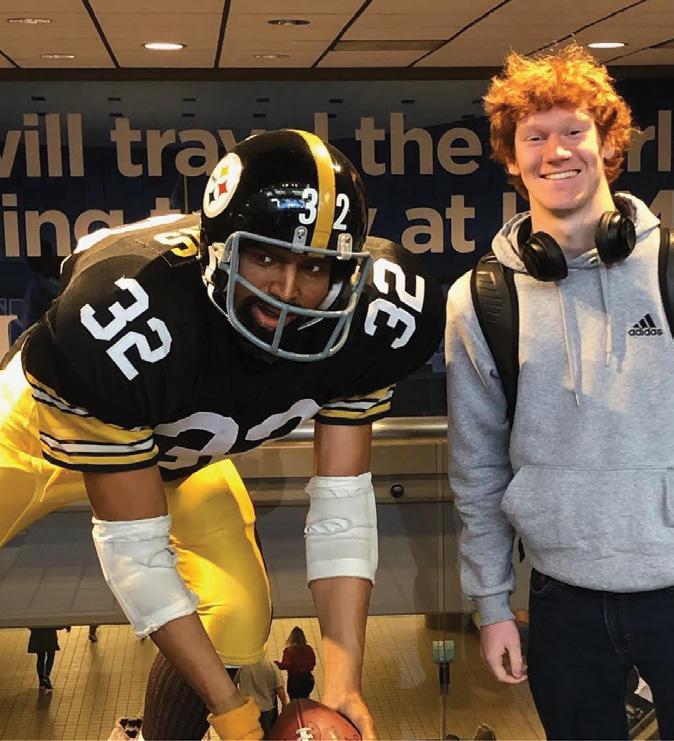

ryland_bickley (editor-in-chief) I’m a sophomore communications major with plans to finish my bachelor’s at Oregon State starting next year. Outside of The Commuter, I’m a member of LBCC’s Civil Discourse Program, a sportswriter for SB Nation, an amateur guitar player, and a truly horrendous gamer.
Go-to weeknight meal: Spaghetti and meat sauce.
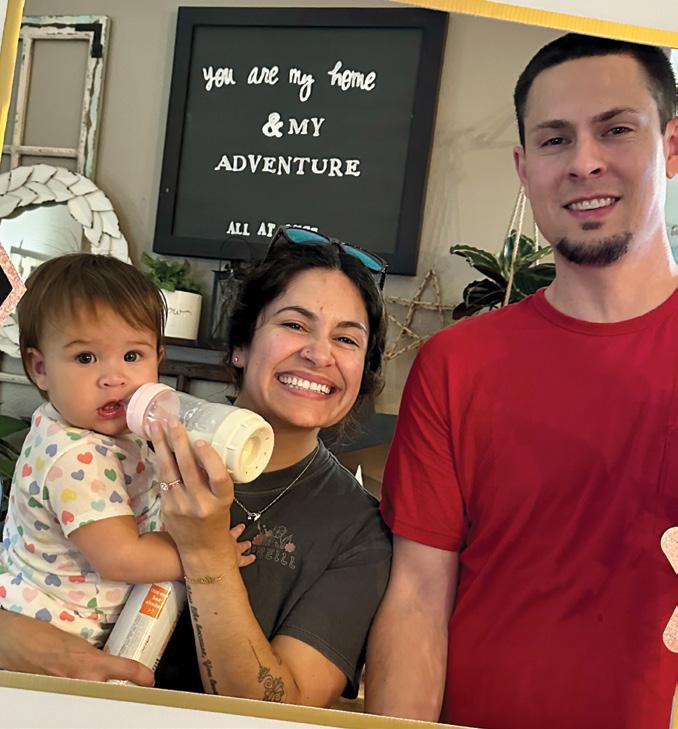

chris_patterson (marketing director) Hi, my name is Chris and I am at LB for the accounting program. I’m a tutor for business/accounting classes here. Also, I am a father of a 1-year-old so I am in a very family-oriented lifestyle.
Go-to weeknight meal: Teriyaki chicken.


emily_jimerson (feature editor) Hello! I’m a sophomore majoring in creative writing at LBCC, and I plan on transferring to OSU next year. In my free time I enjoy spending time with friends, playing video games, and reading.
Go-to weeknight meal: Sushi.
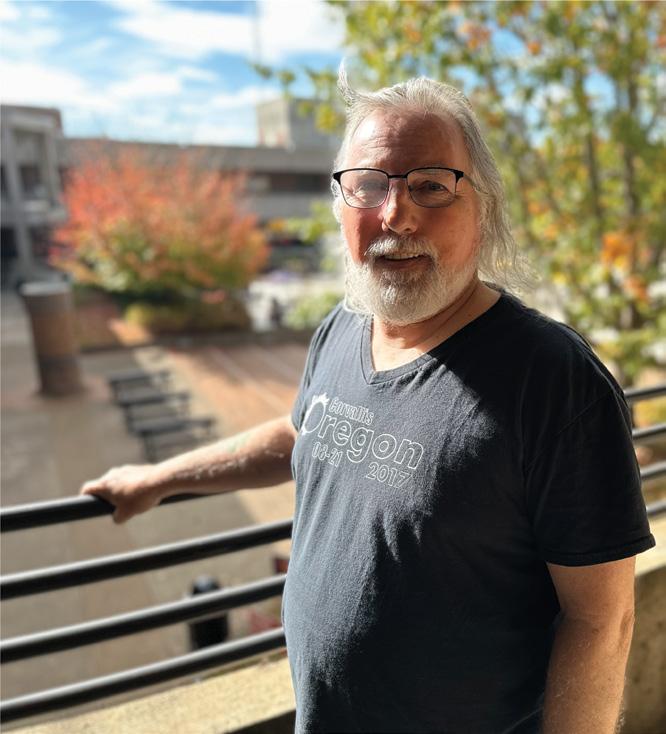

mike_mcreynolds (contributor) I started this journey five years after my life-changing stroke. This woke up my love of writing. I decided, after a 40-year absence, to get formal writing training. I have always spoken my mind. I'm excited for this school year.
Go-to weeknight meal: A thick steak, medium rare, with baked potato and a salad with raspberry vinaigrette.


anthony_drews (contributor) Second-year student majoring in journalism at LBCC, with plans to transfer to OSU this coming year to continue that journey. Perpetually tired connoisseur of co ee. Enjoyer of the sea, the stars, semicolons, video games, and the changing of leaves in the fall.
Go-to weeknight meal: A healthy salad, followed by an extremely unhealthy choice of salt and vinegar chips or cheese crackers.


ethan_birmingham (sports editor) Hello! I'm Ethan, and I'm a sophomore journalism major here at LB! I enjoy sports-related activities, whether writing about them, participating in them, or just watching a game! Next year, I plan on transferring to either OSU or UO to obtain my bachelor's degree.
Go-to weeknight meal: Bacon macaroni and cheese.


brittany_king (contributor) I’m an art major with a focus on business, with the potential to transfer to a four-year university. I live and breathe photography with the goal to capture the stories that people overlook. If I’m not behind the camera I’m lost in a book or o on a side quest, did someone say roll for initiative?
Go-to weeknight meal: Potatoes, my hobbit heart will take potatoes in any form.


mika_winder (contributor) Hello! I am a freshman at LBCC in the visual arts department and I have been involved in journalism for two years as a writer, artist, and editor. I like writing commentary and reviews, but if I were to do journalism as a full-time job I would want to be an investigative journalist. I am going to do my best as a new contributor and I am very excited for the opportunity. In my free time, I enjoy watching horror movies and drawing.
Go-to weeknight meal: Lemon and shrimp risotto (it’s actually pretty easy to make).
words by ETHAN BIRMINGHAM photos by MICAH TEAGUE
On Sept. 21, some of LBCC's greatest athletes and coaches assembled with current student-athletes in the Activities Center. Together the group celebrated the induction of the 2024 class of the Linn-Benton Athletics Hall of Fame.
The gym, usually home to Linn-Benton's volleyball and basketball programs, was refashioned into an elegant banquet to honor those who had made significant athletic contributions to the school.
The event marked the fourth induction ceremony the school has hosted since the creation of the Linn-Benton Athletics Hall of Fame in 2021. The need for the Hall of Fame and subsequent induction banquet had been long overdue, with Linn-Benton having created its first athletic programs back in 1970 under thenDirector of Health and Physical Education Dick McClain.
The banquet helped connect current LinnBenton athletes from across its four sports programs to those who had paved the way for their teams in the ’70s and ’80s.
Once guests finished enjoying their dinner and conversations with their fellow Roadrunners, each nominee in attendance had a chance to speak to the crowd about what their time at Linn-Benton was like and what the induction meant to them.
The 1972-73 men's basketball team captured Linn-Benton's first Oregon Community College Athletic Association title in just their third season since inception. Coached by Butch Kimpton, son of 2024 LB Hall of Fame inductee Ford Kimpton, the Roadrunners' highflying tempo led them to a conference record of 15-3 and an overall record of 26-7. The team was known for their powerful offensive play, scoring over 100 points in 13 games, including the OCAA title game against Lane.
Linn-Benton's impressive season gave them a spot in the 1973 NJCAA Region 18 tournament. In the tournament, Linn-Benton made it to the title game before falling to the fifth-ranked team in the nation, Southern
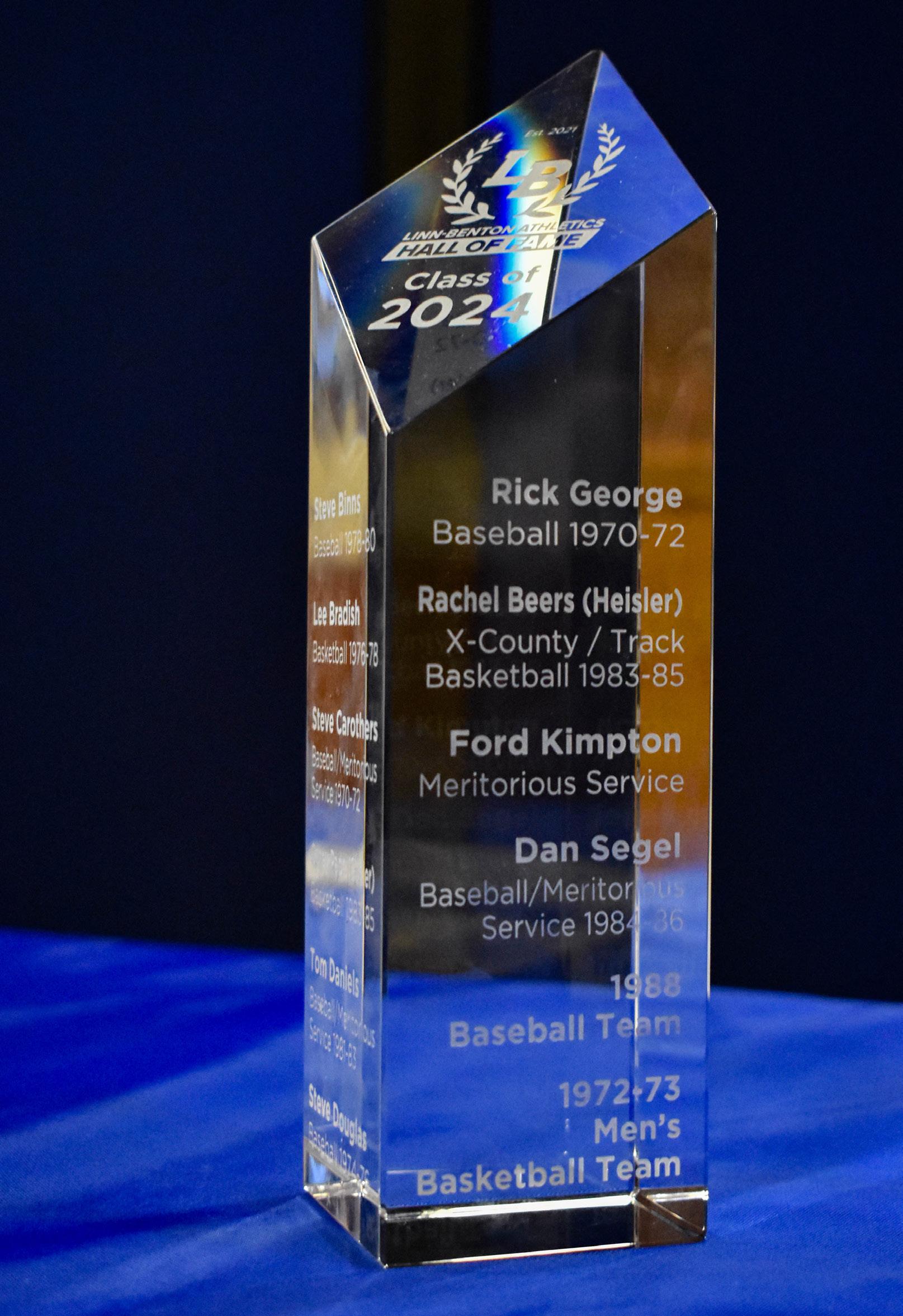
Idaho. The team featured three all-conference selections, Craig Martin, Gary Michael, and Jim Davidson. Martin's season included setting school records for field goal percentage, points, and rebounds, while Davidson set the school record for most career points.
Coached by 2022 LB Hall of Fame inductee Greg Hawk, Linn-Benton's 1988 baseball team won the school's first Northwest Athletic Conference title. The team finished with an overall record of 26-12 and won their third straight NWAC South Region title.
Pitcher Ken Nielsen, centerfielder Dennis Kluss, and left fielder Gary Boyer put up impressive performances for the Roadrunners. Nielsen won MVP of the championship tournament after a dominant 13-strikeout showing in the title game. Boyer earned a spot on the NWAC South Region first team after hitting .382 and stealing 18 bases. Kluss won MVP for the South Region after tallying an emphatic five home runs and 35 RBIs. The 1988 baseball team earned a spot in the NWAC Hall of Fame, forever immortalizing their achievements. Both the scoreboard and the announcer's

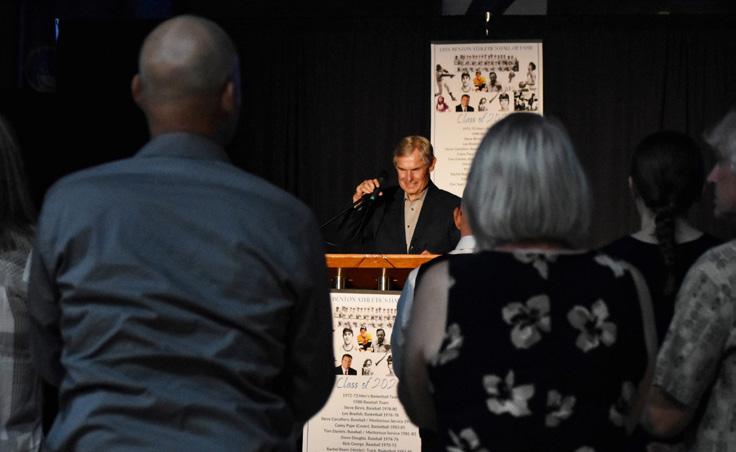

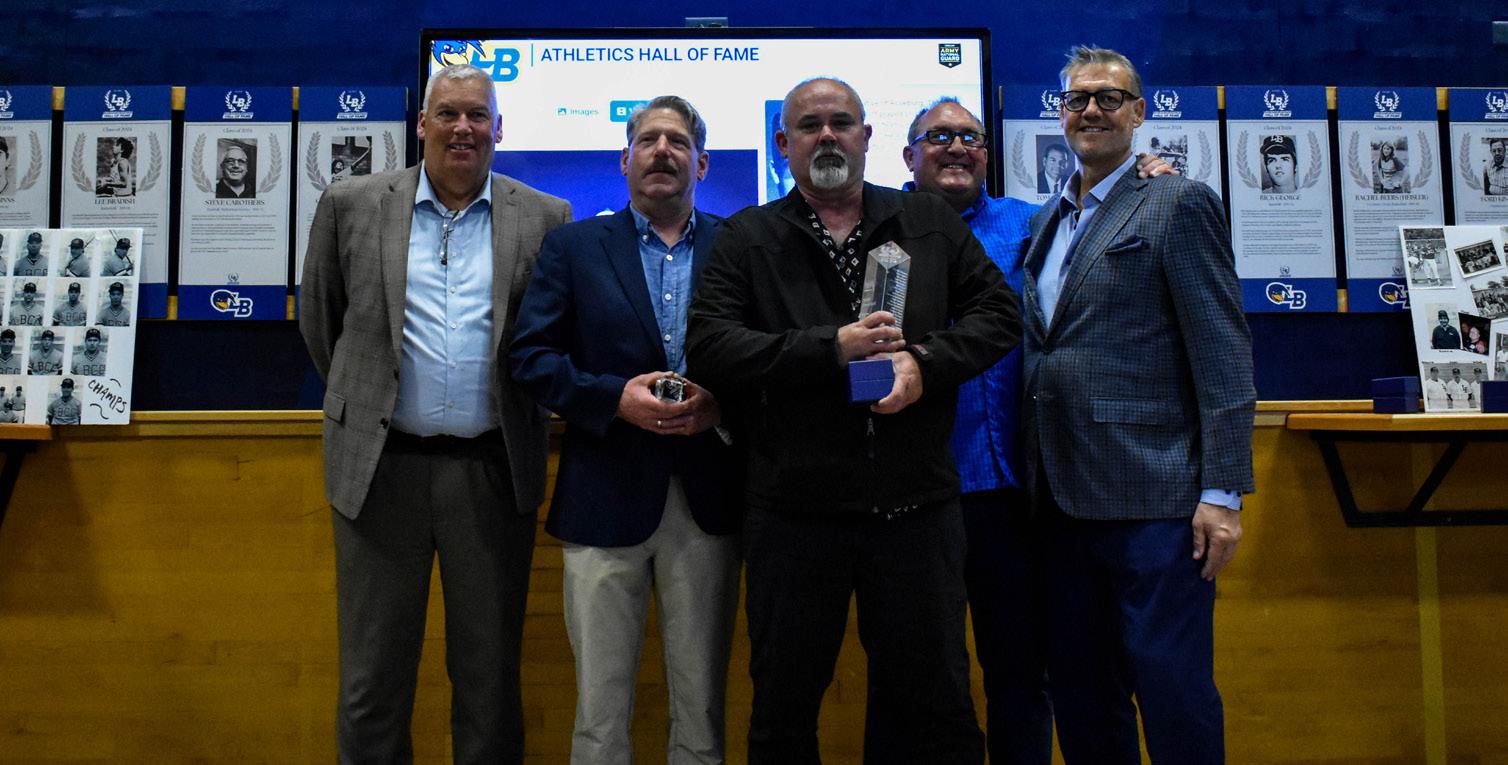
booth at Dick McClain Field pay homage to the team's historic season.
Steve Binns – Baseball, 1978-80
Steve Binns was an integral part of the 1980 Linn-Benton baseball squad that won the OCCAA Championship and the Region 18 title. Binns played left field and finished with a batting average of .393 during his time at LinnBenton. Binns' outstanding 1980 season earned him a spot on the OCCAA All-Star team and a selection to the All-Region 18 second team.
Following his time at Linn-Benton, Binns played at Portland State University, where he set
school records for most hits, runs, and at-bats in a season. The NWAC honored Binns's legacy by inducting him into the NWAC Hall of Fame in 1999.
Lee Bradish – Men’s Basketball, 1976-78
Lee Bradish was a key member of the 197778 Linn-Benton men's basketball team that reached the final of the OCCAA tournament. Bradish earned back-to-back spots on the allconference first team during both seasons at Linn-Benton.
Bradish was the third-highest scorer in the entire OCCAA during his sophomore season.

He holds the spot for third-most career points for men's basketball at Linn-Benton, tallying 1,102 points during his tenure. After graduating from Linn-Benton, Bradish played for the University of Alaska Fairbanks.
Steve Carothers – Baseball, 1970-72
Steve Carothers was a starting pitcher for the Linn-Benton baseball program during their first two seasons in 1971 and 1972. Carothers led the Roadrunners to back-to-back OCCAA Championships, a feat that inducted the 1971 baseball team into the Linn-Benton Hall of Fame. Carothers maintained his exuberant support for Linn-Benton athletics following his playing career, contributing to the reinstatement of the Linn-Benton baseball and women's basketball programs. Carothers has also generously helped with multiple upgrades to the school's baseball facilities. Carothers's contributions to LinnBenton on and off the field earned him an induction into the NWAC Hall of Fame.
Casey Pape (Cosler) – Women’s Basketball, 1983-85
Casey Cosler was a pivotal member of the 1984-85 Linn-Benton women's basketball team that took third place at the NWAC Championship tournament. She was named South Region MVP during her sophomore year and amassed 40 wins during her Linn-Benton career.
Cosler ventured to Western Oregon State College (now Western Oregon University) after Linn-Benton and won NAIA District II Player of the Year while breaking multiple school records. Cosler belongs to several Hall of Fames, such as the Cascade Collegiate Conference Hall of Fame, the NWAC Hall of Fame, and the Western Oregon University Hall of Fame.
Tom Daniels – Baseball, 1981-83
Tom Daniels was the starting catcher for the Linn-Benton baseball team during their 1983 OCCAA title-winning season. Daniels' accomplishments included back-to-back appearances on the All-OCCAA first-team and the All-District 18 first-team. Daniels earned AllAmerican distinctions following a sophomore season during which he hit eight home runs and
achieved a batting average of .392.
After Linn-Benton, Daniels played baseball for Oregon State University from 1984-86. Over the years, Daniels has helped fund the LinnBenton Athletics Advisory Board and hosts an annual poker tournament as a fundraiser for the Linn-Benton baseball program. Daniels' continued support for the Linn-Benton baseball team has led to important facility renovations for the program.
Steve Douglas – Baseball, 1974-76
Steve Douglas was the starting first baseman for the Roadrunners when they captured the OCCAA title in 1976. During his sophomore season, Douglas tallied 45 RBI and 10 home runs. That same season, Douglas was second in the conference for hitting, recording a .400 batting average.
His accolades included an appearance on the All-OCCAA first team, the All-District 18 first team, and a regional Big Stick Award from the sports equipment company Rawlings for having the highest batting average in the Northwest. Following his career at LinnBenton, Douglas joined the University of Oregon's baseball program. Douglas' wife Joy was a member of last year's class of inductees into the LB Hall of Fame.
Rick George – Baseball, 1970-72
Rick George was a member of the first two Linn-Benton baseball seasons in 1971 and 1972, where he started in the outfield. George played a huge role in the Roadrunners’ journey to consecutive OCCAA titles, batting .390 and leading the team with three triples. George couldn't compete in the 1972 OCCAA postseason due to injury but still earned honors on the All-OCCAA first team.
His achievements at Linn-Benton earned him a spot on the baseball team at Eastern Oregon State College (now Eastern Oregon University). George was a unanimous selection to the Albany Democrat-Herald's all-decade
team for his high school and collegiate playing career. George, alongside the rest of the 1971 Linn-Benton baseball team, earned induction into the NWAC Hall of Fame.
Rachel Beers (Heisler) – Cross Country, Track, Women’s Basketball, 1983-85
Rachel Heisler competed in cross country, women's basketball, and track & field during her time with Linn-Benton from 1983-85. Heisler joined the cross country team following the insistence of her coach, 2021 LB Hall of Fame inductee Dave Bakely. In 1985, she was named LB's most outstanding runner for cross country. For the basketball team, Heisler played a significant part in the 1984-85 team that finished third in the NWAC.
After Linn-Benton, Heisler went to Gonzaga University, earning a degree in business administration. Heisler saw her three-sport contributions honored with an induction into the NWAC Hall of Fame in 1999.
Ford Kimpton – Equipment Room and Athletics Event Manager
Ford Kimpton served as equipment and athletics event manager for eight years at LinnBenton. Kimpton was crucial in supporting all Linn-Benton athletic programs and helping student-athletes. Kimpton worked as a manager at Sears Roebuck for 30 years before returning to Linn-Benton as an athletic assistant and equipment supervisor.
While at Linn-Benton, Kimpton was a part of the Northwest Athletic Association of Community College's honor roll. Kimpton served in World War II, earning a Purple Heart after being wounded in combat. Following Kimpton's passing in 1995, Linn-Benton established the Kimpton Scholarship, awarded to second-year student-athletes dedicated to their team and academics.
Dan Segel – Baseball, 1984-86
Dan Segel played first baseman for the

Linn-Benton baseball program in 1985 and 1986. An injury forced an early end to his second season with the Roadrunners, but Segel joined Northwest Missouri State University's baseball program the following year. Segel is a part of the Linn-Benton Athletics Advisory Board and has helped provide financing and leadership for Linn-Benton's athletic programs. Segel contributed immensely to the effort to reinstate the baseball and women's basketball programs at Linn-Benton.
Segel is the current CEO and president of the Corvallis Knights Baseball Club, a team co-founded in 1990. Under his guidance, the Knights have won ten West Coast League Championships since 2007. Segel's contributions led to his induction into the NWAC Hall of Fame in 2005. Segel’s son, Kellen, was a part of LB baseball’s NWAC Championship-winning team in 2024.
▼ Steve Binns.






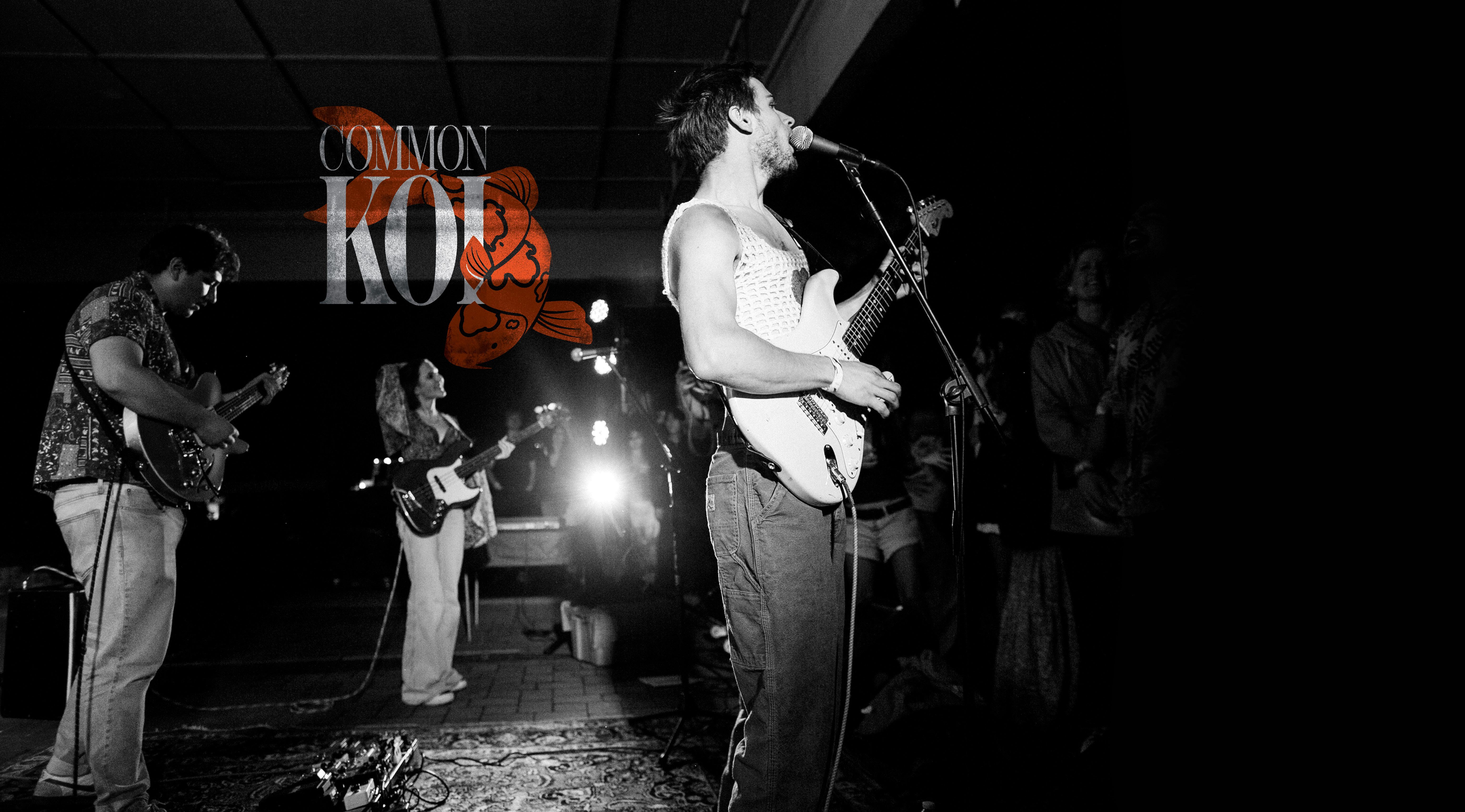

words by RYLAND BICKLEY
s you can tell from our crop tops, we are a serious band!” announced Common Koi frontman Skylar Coy to the crowd before launching into a song at 2024’s Summer’s End music festival.
I met with the indie rock group on the last Saturday of September at the aptlynamed music festival in Corvallis, put on by local booking agency South Valley Sound. It was the perfect time for one last hurrah before summer break ended – the weekend before school started for LBCC, and following week zero for Oregon State. The sunny weather couldn’t have been much better as the band and I chatted at a picnic table under the shade at Bruce Starker Arts Park.
Common Koi formed while they were students at the University of Oregon. “I went to college knowing I wanted to be in a band,” said Coy, who also plays guitar. “I met [drummer Stephen Strong] on the dorm website. It's like a dating app for roommates, and I actually decided that I didn't want to live with him.”
“Thank God,” quipped Strong.
“He was a bit weird, but I knew he was an instrumentalist,” joked Coy. Strong’s roommate, guitarist Jack Keith, soon joined, as did bassist Kira Gelbaugh, who Coy met in a hip-hop ensemble.
Gelbaugh also plays with post-hardcore band Solution Honey. Strong releases music under the name Steve Luvlights. “I’m a band monogamist,” declared Coy.
To my surprise, the band claims that its name has nothing to do with Skylar Coy’s last name. Strong told the full story: “When we first got together, before Kira was even in the band, we were jamming in the basement of our dorm room trying to come up with names,” he said. “One point we had the idea of Doop Snogg, as in, Snoop Dogg, but reversed, you know, like Ritt Momney, Doop Snogg. And we asked a dude if that was a good idea who was passing by. And he said, ‘F— no.’ [Laughs.] So we didn't do that.”
“We had been to a couple house shows [in the Eugene scene],” he added. “And it just felt like there was so much talent and so many interesting characters, you know, and the koi fish are kind of a mystical being. … There's a lot of mythology around koi fish. Skylar loves koi fish. And so to be common among the koi, to feel comfortable among greatness and among mysticism, it’s the idea.”
“Genuinely, when we were coming up with the name, I never thought about ‘koi’ and ‘Coy,’ because they're spelled differently, you know?” said Coy. “And I was excited
about the koi. I love koi fish.”
As Common Koi, the band wrote what is still their biggest hit, 2022 single “Clout,” the day Gelbaugh joined the group. “We started playing college house shows, and just kind of kept going,” said Coy. Their first EP “POND” followed soon after.
The band’s latest, debut album “Bestfriends,” was released in May of 2024 by the trio of Coy, Strong, and Gelbaugh. “We sacrificed our other guitar player to a volcano,” said Coy. (Keith contributed additional guitar to the album.)
The band’s newest member is guitarist Wyatt Qualiana, who’s been with Common Koi for the last few months. “There was definitely some intimidation at first,” he said. “But you know, everyone's made me feel very much at home, that my contributions are well-received. And for that, I'm very grateful.”
Qualiana has fit in well with the Common Koi sound: bouncy rhythms, jazzy flourishes, intricate arrangements, and the feel-good vibes of the West Coast.
“Everyone's parts are so interconnected that if I want to change something on the vocal, it usually means everyone else has to change something too,” said Coy. “Everything is so codependent.”
“We do a lot of just keeping our ears open to what people are playing,” Gelbaugh said of the band’s collaborative songwriting process. “So like, jamming chords and being like, ‘Oh, Steve, I heard that triplet fill, what if we do that three times and then go into this other thing?’ Or, ‘There was a harmonic line that was cool. Let's try to harmonize that.’ And that could be almost like a little proggy bit. Or just hearing what organically comes out, and then, ‘Oh, let's snag that!’ So really, just keeping our minds open to what comes up naturally.”
“Stuff we've been playing is nothing crazy chord-wise or chord progression-wise, but there's all these little dynamic parts and stuff [which the band referred to as ‘sauce’] that kind of make a song a song, rather than just a jam,” said Qualiana. “I think it's definitely a multifaceted thing, where the jamming provides quite a function, but then there’s the process of subtraction, just slicing little pieces off, tweaking them, and then seeing if they sound good.”
“Everything that's in our songs has a reason that it's there,” said Coy.
On “Bestfriends,” the music remains true to Common Koi’s sound, but it’s also bolder and more diverse than before. There’s melodic indie-rocker “Everything That Goes Wrong in a Movie,” “Payton’s Revenge,”


with a jumbo-sized, singalong chorus and horn section, the ’80s-tinged “Co-Star,” and acoustic-led closer “Escaping.” Every song is catchy, and there’s a range of emotional depth to enjoy as Coy’s vocals range from playful and conversational to strained and heartfelt.
“We'll often take the feeling of something and then make it into a much grander song,” Coy said of the band’s lyrics. “Kind of like an extrapolation. … A lot of the things are based in reality, like lots of shout-outs to my girlfriend, lots of shoutouts to experiences we've had. But there's also songs on there that are just completely for fun, like our song ‘Drifters’ is about an unrequited love/getting lost in the jungle/ being a dumba–, you know?”
“It's a feeling. It's not necessarily a message,” he added. “I would say a lot of the songs carry an overarching theme of our journey together as friends and as a group. … We've known each other through all these experiences that we've had, and a lot of it's just about how we've ridden together and we've done everything together.”
The band’s chemistry shines on their latest album.
“We let loose on ‘Bestfriends,’” said Coy.
Added Gelbaugh, “Especially writing the second half of the album, we're just like, let's just… “…do what feels good in the moment,” finished Strong.
It was a different process than “POND,” which Coy said “was pretty calculated, like we had tested and played all of those songs at shows before to make sure they hit.”
Still, “Bestfriends” was a labor of love to create. “It took us like a two-and-a-half year process to put it out and really make it seem cohesive,” said Gelbaugh.
The band’s sound pulls from a number of influences, with the group referencing many Eugene-area bands.
“We've been lucky to have been surrounded by a ton of musicians, living with other bands and solo artists and playing with bands over the years,” said Gelbaugh. “So I feel like a lot of our stuff is a culmination of what we've been hearing and playing with for the past five years.”
I also had the band share which artists were currently on their playlists. It yielded an eclectic list, from LA LOM to Chris LeDoux to Gustav Holst, The Killers, Mk.gee, Albert Hammond Jr., Playboi Carti, and, although reluctantly admitted, Drake.
album. “Lyrically, it's about shooting someone. It's about going insane,” said Coy before clarifying: “And like, I never was so insane that I shot someone.”
The song served as the closer to Common Koi’s set at 2024’s Summer’s End – the first after-dark performance of the festival.
Common Koi are no strangers to Summer’s End, with 2024 marking their third year playing it. They referenced 2023's show being one of their favorites. “I played with laryngitis last year, and it was still lit,” said Coy.
Although Eugene-based, the band has an appreciation for the Corvallis scene. “We love it here,” said Gelbaugh.
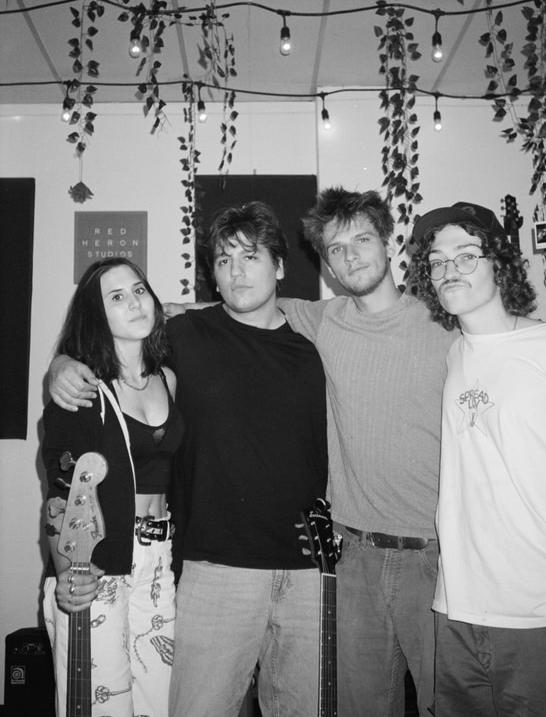
“I feel like the music was pretty intertwined with our lives,” said Coy. “It took so long, you can almost see the journey of the band and what was going on in our lives throughout the album, different phases. A couple months we were really into pop, and then we became kind of punk/metal-ly – for like four months, we were all really pissed off at something. And then there was a big folk period. So you get all these weird genres throughout the album. But I mean, I think we were all just like, ‘Let's just release it and see what happens.’ I mean, it's all you can do, right?”
“I think all of that kind of comes through in our music, too, that we're all over the board,” said Strong.
“Drake does come through!” laughed Coy. He’s not wrong, either – a pop influence is easy to hear in the band’s discography, and autotune creeps into the final chorus of “Drifters.”
“We always try to make our choruses slap,” said Coy. “We spend a lot of time hitting the slap-o-meter.”
The chorus of “50 Ways to Call the Void” might be the catchiest on the new
“Eugene house shows and dive bars have been our comfort zone, you know? And when we started writing music, we were almost writing to that audience of Eugene college students and stuff like that,” said Strong. “But we've been on a couple little tours. We played in Corvallis a lot. Corvallis just has such a good energy, like, everybody's there to party, but also equally there to really listen to the music and enjoy.”
Following Summer’s End, the band teased an upcoming show at Eugene’s WOW Hall, “WOWHalloween,” on Oct. 26. “It's gonna be a big one, and then we're gonna take a little bit of a break,” said Gelbaugh. She’ll be moving to Los Angeles later this year.
Coy announced the news to the crowd at Summer’s End: “She’s gonna make it, y’all!”
While 2024 might mark the end of this era of Common Koi, the band still has plans. “We're hoping to record in December or January some new stuff that we've been writing, and hopefully get to play a show up here every couple months or once a month, depending on how it goes,” said Gelbaugh. “And I'd love to have us down in LA, too.”
“Definitely the dream,” said Strong.
It’s a bittersweet moment, but also one that shows just how far Common Koi has come since its inception in a dorm room basement. Coy’s lyrics from “Clout” seem oddly prophetic: “My parents are always saying that I need a job / But my band’s about to take off / Woah oh oh oh oh…”

Located in Forum 109 by the fountain

The American Association for Women in Community Colleges presents the FREE Clothing, Jackets, & Shoes!

Tuesdays 11am - 1pm & by appointment
Need an appointment? Scan here! ALL Students are welcome to come shop for FREE!

MOVIE: The Wild Robot
DIRECTOR: Chris Sanders
STARRING: Lupita Nyong’o, Pedro Pascal, Kit Connor, Catherine O’Hara, Bill Nighy, Stephanie
RATED: PG
OVERALL RATING: ★★★★★

hris Sanders (Lilo & Stitch, How to Train Your Dragon) returns to the world of animation this year with his heartfelt and emotional adaptation of the hit children's book by Peter Brown The Wild Robot.
The movie follows a robot named ROZZUM Unit 7134, also known as Roz (Lupita Nyong’o), as she is stranded on a desolate island after the cargo ship she was on crashes during a typhoon. Once on the island, she must learn to befriend the wildlife and defy her nature as a robot to integrate into this nontraditional society.
In almost every way this movie is in the upper echelon of what animated films can be. The most obvious and most striking thing is the gorgeous animation style. Everything that is natural, such as the water, forest, and animals, is animated with a watercolor-painted style, while anything mechanical such as Roz or the human environments are rendered in the typical, although still stylized, 3D animation that Dreamworks uses. This juxtaposition of
styles leads to some really fantastic blending of the two later in the movie, particularly with Roz herself.
Although Roz is a robot character, Lupita Nyong’o plays her with an unwavering humanity that will make you almost forget that she is an artificial lifeform at times. Her vocal performance changes throughout The Wild Robot as Roz learns what it means to care and to love others as people. The other characters like Brightbill played by Kit Connor and Fink played by Pedro Pascal are also fantastic. The actors really put work into their performances and lost themselves in the movie so that none of the characters, even small side ones, felt like they were just an actor being themselves.
The film is an emotional masterpiece and one of the most effective stories of humanity that has been released in the last couple years. It tackles themes of motherhood and love with a tenacity and realism that is somewhat uncharacteristic of a modern children’s movie. The evolution of every character in this movie is complex and adds a depth to the story that
not many American animation studios can truly capture.
As an adaptation it is great; there are some characters that are removed and some scenes that are combined together, but none of those choices take away from the meaning or the emotions of the movie. It’s clear that Sanders was deeply loving of the source material and wanted to respect it to the fullest extent. In every case, the most emotionally charged moments from the book are just as, if not more, powerful in the movie.
There is a charm to this movie that not many storytellers or directors can harness, yet both Chris Sanders and Peter Brown utilized the full spectrum of human emotions to create a heartfelt and strikingly emotional story of motherhood, love, and most importantly, humanity. In almost every way imaginable, The Wild Robot has set a new standard not just for children’s movies, but animated movies in general.

MIKA WINDER
BUSINESS: Sugar J’s Ice Cream Workshop
LOCATION: 226 2nd Ave. Albany, Oregon
OVERALL RATING: ★★★★
In 2023, CNN Business reported that American ice cream consumption had gone down by nearly a third since 1986, and it’s no surprise that this statistic is reflected in the disappearance of “old-fashioned” ice cream parlors across the country. The new Sugar J’s Ice Cream Workshop in downtown Albany is a modernized take on the traditional concept, but can it live up to expectations?
After several months of work to transform the long-empty building next to the current Greyhound Tavern and Bar into a colorful and modern ice cream parlor, the Albany branch had its soft opening on Aug. 14. The Corvallis location has been open and thriving since July of 2021, earning a 4.8 rating on Google with 220 reviews, so the Albany branch has big shoes to fill.
One of the main appeals of Sugar J’s is its diverse and unique list of flavors, prioritizing quality and novelty over quantity. With the recommendation of the server at the time, I chose the London Fog flavor in the extra small size – which was still a reasonable amount of ice cream. The prices are a little high, but given the specialty flavors and the atmosphere, it’s worth the splurge for ice cream lovers. The London Fog flavor looks just like the drink, with a pale brown base that has a few visible specks of tea leaves or vanilla. It has a mild, sophisticated flavor with a sweet and creamy base undercut with the earthy scent of bergamot and dried citrus. It would be delicious in the affogato option or enfolded in one of Sugar J’s freshly made waffle cones, but it was also refreshingly simple on its own.
In terms of atmosphere, the Albany location is similar to the Corvallis branch with a mix of natural wood benches and pops of color and geometric shapes on the walls and the counter. Small touches like the color-changing spoons and rainbow light fixture make the experience more memorable and unique. I always love to see a business with a strong personal aesthetic, and Sugar J’s commits well to its color palette and textures without being overwhelming or sickly sweet. There are multiple murals as well, which make the space feel even more integrated with the color scheme and fill the wall space. There are parts of the interior design that do feel a bit unfinished, especially the area to the left of the door where there are no tables or furniture save for the water station. The space is pretty large, which can lead to a feeling of emptiness and industrialism when it isn't filled or sectioned into smaller areas. I think something like this could easily be solved in the near future, however, and the existing decor creates an environment that is cute and upbeat but not childish.
Ultimately, Sugar J’s proves that traditional ice cream parlors are possible to reinvent for the modern age while still keeping a personal flair. Its greatest strength is the ability to appeal to the entire family with the usual options for children along with more sophisticated flavors for parents, or anyone who wants to treat themselves. If you're looking for a way to indulge this weekend, Sugar J’s Ice Cream Workshop might just be the cream of the crop.


Monthly music recommendations to keep you inspired.

Dreams
Fleetwood Mac
OK, the lyrics to this one aren’t as uplifting as our usual picks for Anthem of the Month. But “Dreams” perfected the art of chill fall vibes. It’s a timeless track from a legendary classic rock group (and from one of the greatest albums ever made!).






01. 'Charlie and the Chocolate Factory' author Roald
05. Do in, as a vampire
09. Elroy Jetson's dog
14. Bassoon's smaller cousin
15. Towel (o )
16. Propelled with oars
17. '50s craze that had people going around in circles
19. Construction site machine
20. Hog haven
21. Long times
22. Pirates' treasure holders
23. Team supporters
24. Compete
25. Give up the occupancy of
28. 1970's fad for the nurturing challenged
33. Cupid counterpart, to the Greeks
34. Needing a bath
36. Gaucho's cattle catcher
37. Tree house
38. Bunkhouse bunk
39. Component of 37-Across, usually
40. "This one's ___!" ("My treat!")
41. Common dog biscuit shapes
43. Bone near the radius
44. '70s fad jewelry
46. XXX, on a valentine
48. Billboard messages
49. Japanese rice wine
50. The ___ Brothers ("Listen to the Music" band)
54. Construction locale
55. West of "My Little Chickadee"
58. Opened, as a knot
59. 70s fad that revealed much about a person
61. Stir up, as a fir
62. Stadium section
63. Bump ___ (meet)
64. Copy machine powder
65. Big co ee dispensers
66. Golf ball stands
01. Homer Simpson outbursts
02. Be adjacent to
03. "Monty Python and the __ Grail"
04. Grassy plain
05. Fainted theatrically
06. Kings of the jungle
07. Smartphone programs
08. "A rmative"
09. Bow and arrow user
10. Sight for ___ eyes
11. '___ the night before Christmas...'
12. $2,000 for Boardwalk, with a hotel
13. Celebratory poems
18. Summer oppressiveness
22. Part of N.Y.C.
23. Went without food on purpose
24. Classic Chevy, for short
25. Snake poison
26. "There ___ exceptions" (Everyone must)
27. Women's magazine, familiarly (or Kramer of "Seinfeld"'s first name!)
28. Pitchfork point
29. Like angles between 90 and 180 degrees
30. Batman's had little bat ears
31. "A Fish Called Wanda" Oscar winner Kevin
32. Heroic legends
35. Computer mini-pictures
41. ___ one's time (be patient)
42. Ice-show performers
45. Indiana Jones or Lara Croft, e.g.
47. Furniture chain founded in Sweden
49. Emergency vehicle sound
50. Covering on attic items
51. Aware of, as a scheme
52. Have too much of, for short
53. Kid's transport
54. Blend with a spoon
55. Source of gold
56. Initial poker stake
57. Narcissists have big ones
59. Good name for a gumbomaker
60. Caboodle's partner

Come to a FREE comedy show in honor of Disability Awareness Month, brought to you by LBCC Accessibility Resources!

Check out their TEDx Talk:
Disability is not inability!
Come enjoy a hilarious and witty set by Hayden Kristal, a deaf comedian that does not let their disabilities impact their ability to make people laugh. Hayden Kristal is a Brooklyn-based comedian and public speaker who left a career in zookeeping to pursue comedy. They are known for addressing topics related to diversity and intersectionality, having spoken at major institutions like Harvard, Yale, and TEDx.
Comedically, Hayden has been a semifinalist for Stand Up NBC and a finalist for Full Frontal with Samantha Bee’s Comedy Writing Mentorship, and has opened for Maria Bamford. They combine humor and advocacy in their performances, making them a unique voice in comedy, public speaking, and advocacy. For more details, visit Hayden Kristal's website.